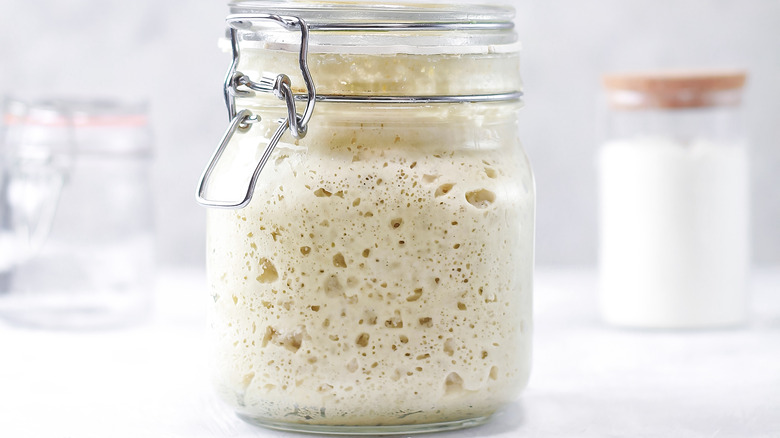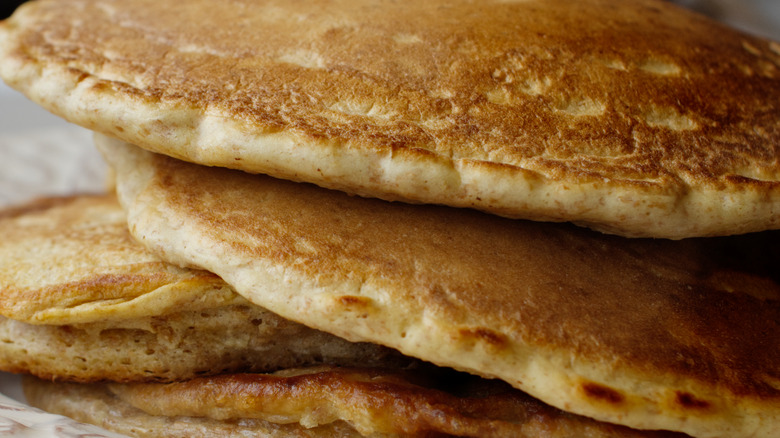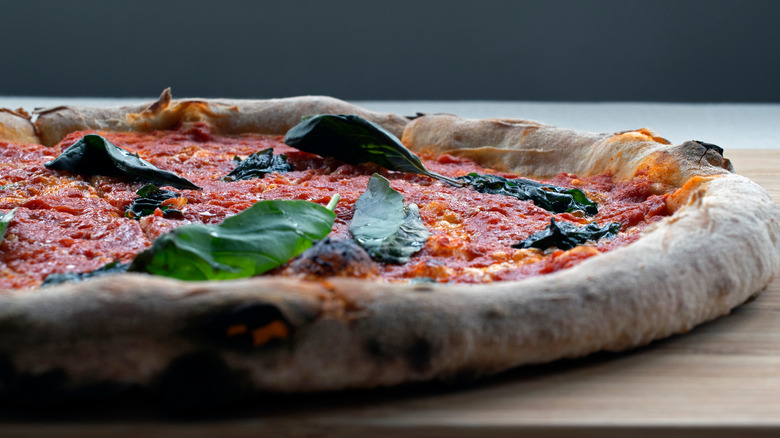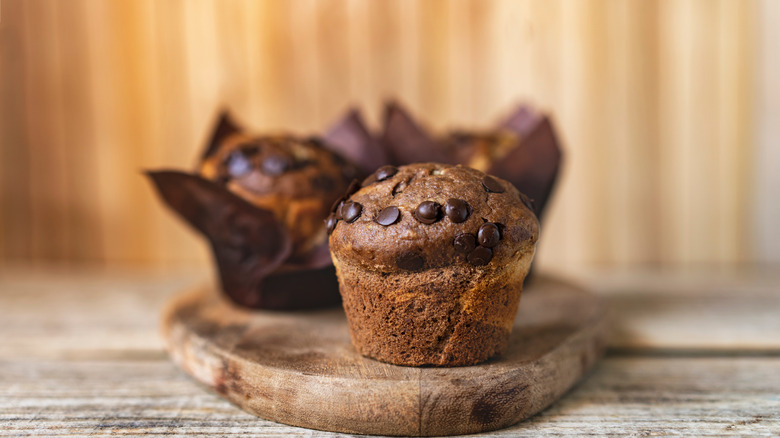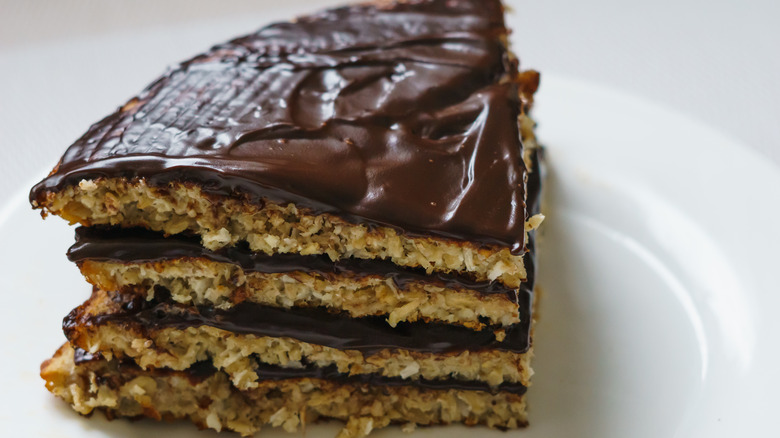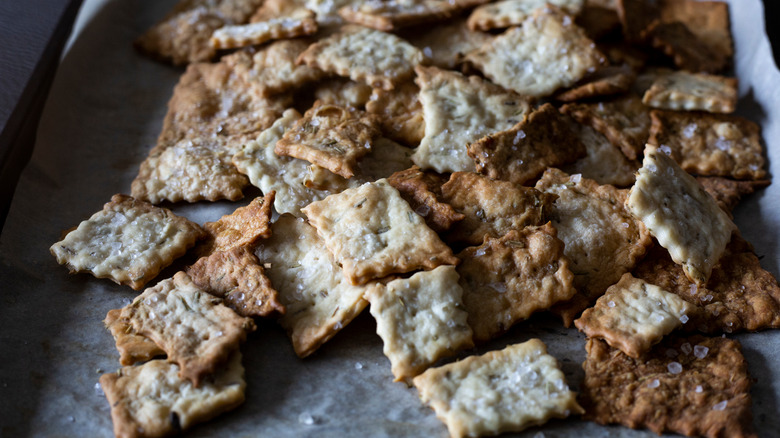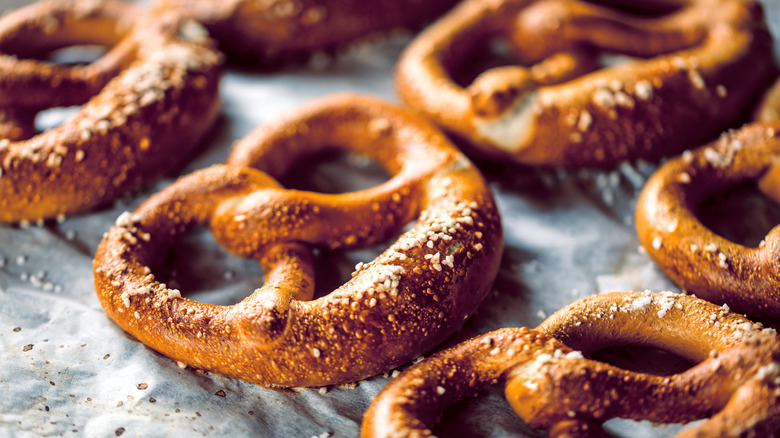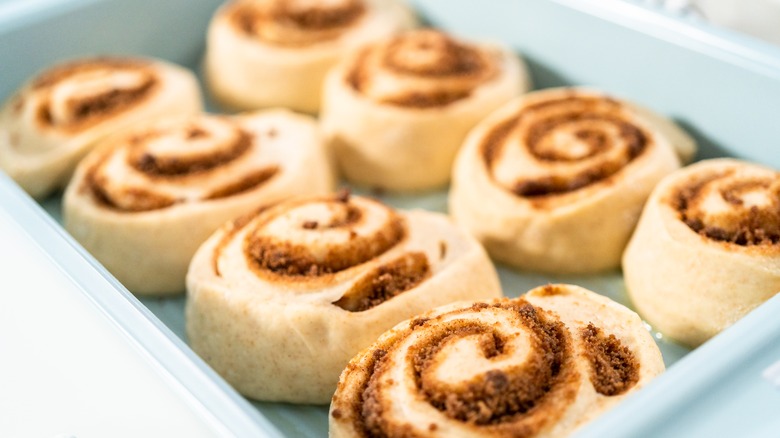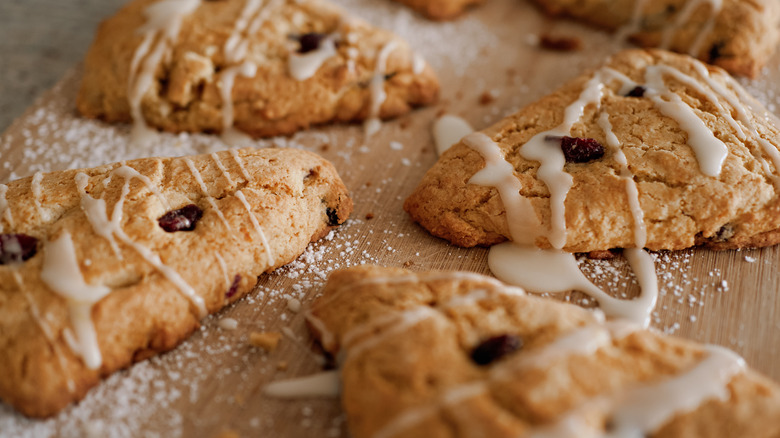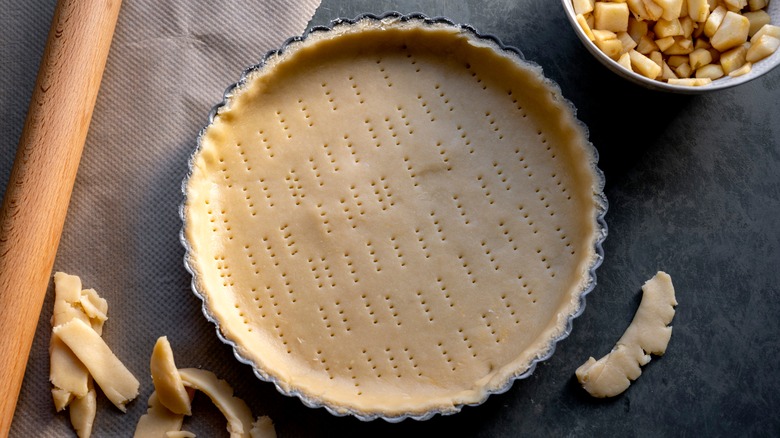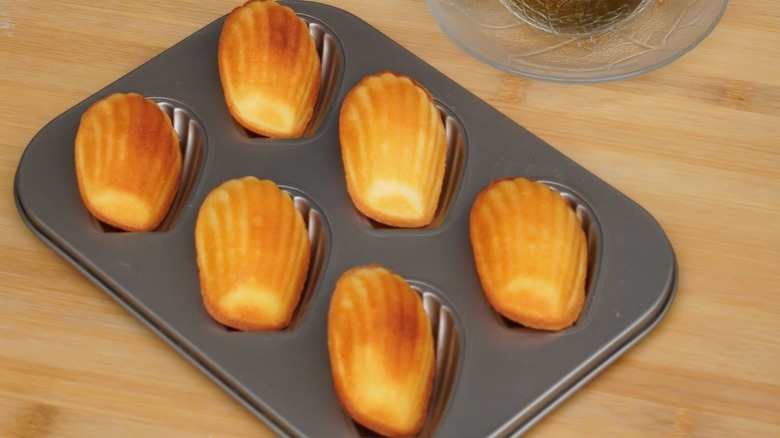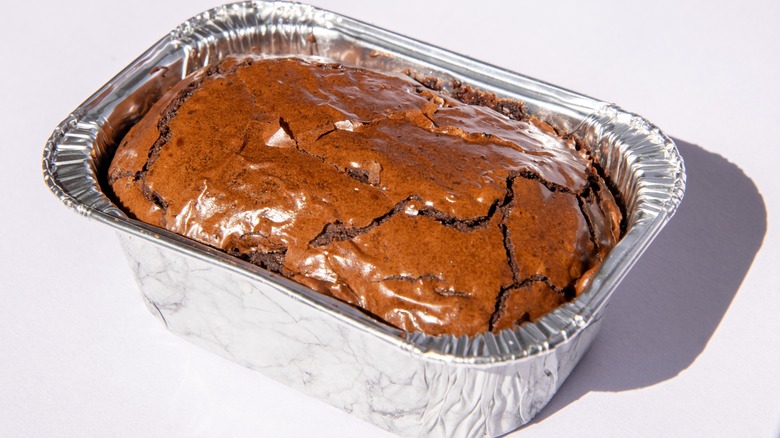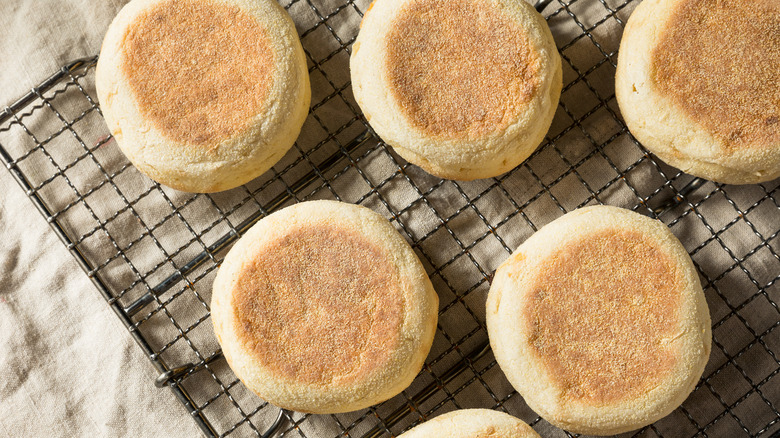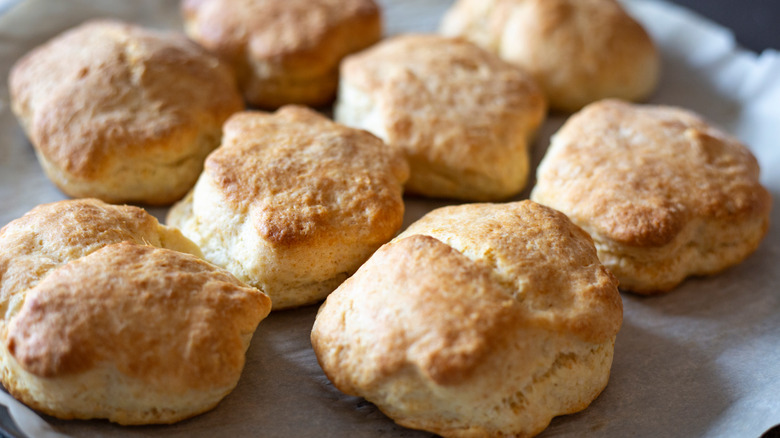14 Best Ways To Use Your Sourdough Discards
We may receive a commission on purchases made from links.
Sourdough was perhaps the best food trend of the stay-home-stay-safe portion of the COVID-19 pandemic. Home cooks everywhere were reading up on how to concoct a sourdough starter at home with two simple ingredients: flour and water. Unlike other yeasted types of bread, sourdough is formed through a natural fermentation process in which wild yeasts colonize and grow on this flour-and-water mixture in a matter of days (via King Arthur Baking Company). The resulting slurry has a unique sour flavor and aroma that give sourdough its distinct profile.
The most laborious part of making a sourdough starter is discarding and "feeding" the yeast colony daily. For each feeding (which can be in 12 or 24-hour intervals), the baker will remove 113 grams of the starter and feed with another 113 grams of flour and 113 grams of water. This results in a lot of sourdough starters being thrown away. Rose Levy Beranbaum, the author of "The Bread Bible," notes that removing some of the starter at each feeding is important because it allows the baker to keep the starter from becoming too unmanageable, also while giving the yeast more space to grow and colonize (via Epicurious).
But what can you do with the sourdough discards each time you feed your starter? Here are some creative ideas to put that starter to good use and make even more flavorful food in your kitchen.
Griddle sourdough pancakes for breakfast
Pancakes are a crowd-friendly breakfast, so why not add some sourdough starter for a unique twist that everyone will love? Use one cup of starter for every two cups of all-purpose flour. The pancake gets a boost in tang from the sourdough — as well as a little help from a splash of buttermilk. Add the buttermilk, unfed starter, flour, and salt together overnight so that the starter has ample time to colonize the flour. The eggs, oil, butter, and baking soda is added in the morning once the pancakes are ready to be cooked. To make the most fluffy pancakes, we recommend using a balloon whisk and not over-mixing the batter. As with all baked goods, beating the flour too much causes gluten strands to form. The gluten makes the pancake chewy and dense. The balloon whisk is important for incorporating air into the batter before it cooks.
This recipe can be modified to use a gluten-free starter and a gluten-free flour mix. For a vegan sourdough pancake, try using an egg replacer and a homemade vegan "buttermylk" with dairy-free milk and apple cider vinegar. Top your pancakes with whatever toppings you see fit — fresh fruit, maple syrup, or chocolate chips.
Customize a sourdough pizza crust
Pizza is a great way to use up some of your unfed starter. King Arthur Baking Company recommends making a sourdough pizza crust using a simple mix of pizza (00) flour, sourdough starter, water, and salt. You'll also want to use active yeast or instant yeast for a pizza dough to maximize rising volume on the dough. According to the website, the dough takes between two and four hours to double in size; for a quicker rise, the baker can either place the bowl in a warm spot or double the active dry or instant yeast in the recipe.
The length between feedings dramatically affects the taste of this pizza crust. A starter that has gone several days without feeding will take much longer to rise and present with a more tangy flavor. However, a sourdough that is regularly fed will not be as tangy and rise more quickly.
Prepare a tray of sourdough muffins
Sourdough muffins are a versatile canvas for both sweet and savory profiles. Cultures for Health recommends combining ½ cup of sourdough starter to 1½ cups of whole wheat flour, which provides a more fibrous taste for the muffin. Using whole wheat flour in tandem with an active culture helps promote better yeast growth than a white flour (via "Peter Reinhart's Whole Grain Breads"). This is because whole wheat flour contains more beneficial microorganisms and minerals than white flour.
These muffins are super fluffy thanks to a helping of eggs, butter, and baking soda. Muffins can be flavored with fresh fruit, like apples, blueberries, or peaches, and chopped almonds, walnuts, or pistachios. Try baking a double chocolate sourdough muffin made with sour cream, cocoa powder, chocolate chips, and standard sourdough muffin ingredients. If you prefer a savory sourdough treat, make an Italian-inspired muffin with honey, chopped cherry tomatoes, chopped fresh basil, and minced garlic.
Bake a sourdough cake
The ideal cake is moist, sweet, and anything but boring. So why not make it even better with the addition of sourdough discard? Sourdough starter can inhibit gluten development in cake batter — which makes the cake fluffy rather than stodgy. The byproduct of the yeast's fermentation, alcohol, also brightens flavors in the cake batter. True Sourdough notes that enrichment from the eggs, butter, and oil can diminish the sourness of the sourdough, so your cake will still taste like cake rather than a rustic sourdough loaf.
Discard can be used in many different types of cake recipes including a dense chocolate bundt cake. Using a bundt cake pan in lieu of a traditional sheet pan develops more crispy edges and an ornate shape. Plus, you can decorate the finished bundt with a helping of decadent chocolate buttercream icing. Pound cake is made more delicate via sourdough; use one cup of starter for every two cups of flour in a pound cake. You'll taste a delicious sweet undercurrent amplified by a citrus glaze.
Consider sourdough crackers for snacking
Thin, crisp sourdough crackers are a simple way to use up excess sourdough starter. Unlike other sourdough recipes that use a low ratio of starter to other ingredients, sourdough crackers are almost entirely made of sourdough starter. Plus, the dough can be refrigerated for up to a day before baking.
There are several different ways to make homemade sourdough crackers. You can roll the dough out with a traditional rolling pin, or save time and feed it through a pasta roller. The key to a great sourdough cracker is making sure that the dough is as thin as possible; this means the cracker will be crispy. Seasonings can include flaky sea salt, herbs de Provence, or dried rosemary.
Top the crackers with either a savory soft cheese or a sweet jam. Brie is a great companion to sourdough crackers on a cheese board because of its extra-buttery core. You can also switch up the blend of other flours used in the cracker to include rye flour, buckwheat flour, or whole wheat flour.
Make sourdough pretzels
Sourdough is the perfect accessory to pretzel dough because it provides a distinctly sour taste that accentuates the salty toppings. Some soft pretzel recipes use bread flour and active dry yeast to quicken the rise time of the pretzel; this may need to be adapted when sourdough is added to a pretzel recipe.
The pretzel flavor is derived from non-diastatic malt powder, a barley derivative that adds sweetness and darkens the color. A vital part of the perfect twist is boiling pretzels in a baking soda bath with malt powder for 10 to 15 seconds before baking. Not only does this improve the final color of the pretzel post-bake, but it also creates a chewy exterior and soft pillowy interior. Fear not — boiling will not alter the sourdough flavor of the pretzel.
Top your pretzels with the traditional melted butter and pretzel salt or dust them in cinnamon sugar for a sweet twist. Serve with your favorite dipping sauce.
Serve sourdough cinnamon rolls for breakfast
Cinnamon rolls are another baked treat that can benefit from sourdough. Use a blend of white whole wheat flour and all-purpose flour, along with a hefty portion of sourdough discards, for a fluffy cinnamon roll with tons of flavor. Since the ideal cinnamon roll is poofy and soft, adding a bit of commercial yeast to the dough recipe is key to creating a classic cinnamon roll texture. Not only will this give a better rise to the dough, but it is also beneficial when working with a starter that is not completely "ripe" (ripeness meaning the amount and activity of yeast in the starter).
When working with discards in a sourdough cinnamon roll recipe, it is important to give the dough ample time to rise. Many recipes with cinnamon rolls and pillowy yeasted breads require a dual-rise time both overnight and after the rolls are formed. This maximizes the time the yeast has to be active and emit the carbon dioxide that gives the cinnamon rolls a rise. Pair the finished cinnamon rolls with a cream cheese icing or a scratch-made glaze with icing sugar and milk.
Incorporate sourdough into your scones
Scones are buttery and delicious whether you enjoy them in the morning, during afternoon tea, or, quite frankly, at any time of day. Sourdough aids in the formation of a super crumbly scone by slowing gluten development. Using a food processor to briefly combine the scone dough prevents the formation of long gluten chains in addition to evenly distributing the ingredients.
Sourdough can extend the shelf life of baked goods like scones, as well as amplify flavors. Scones can be adapted to profile either sweet or savory flavors. For a savory scone, combine shredded cheddar cheese, cooked bacon, and chives. If you prefer a sweet scone, add dried fruit (we recommend cranberries or cherries), chocolate, and chopped nuts. The scone dough is not naturally sweet, especially with the addition of a tangy sourdough starter, so bringing in ingredients with a naturally sweet flavor profile can make the scone all the more decadent.
Form a sourdough pie crust
We all love a flaky, crumbly, yet robust pie crust. Sourdough is a great addition to pie crusts for both structure and flavor. You'll want to use a 100% hydration sourdough for this recipe; this means that the starter has equal parts water and flour, per Northwest Sourdough. Using a 100% hydration starter in a pie crust will not impact the wetness or the dryness of the dough, meaning that you won't have to dramatically change the ratio of liquid to powders in the recipe. A pie crust can be easily made vegan with the substitution of coconut oil and vegan butter sticks for the butter or lard.
The best part about a sourdough crust is that it is adaptable for many different fillings. Summer nights are a great time for this blueberry crumb pie recipe, which is accented with a hint of lemon. During the colder times of the year, you might be tempted to make our warm chicken potpie recipe to share with your family. You can also adapt the sourdough crust to make hand pies.
Upgrade your cookies
You might not think of using sourdough in a cookie, but it is actually a great addition for making the perfect crumbly cookie. Sourdough starter in a chocolate chip cookie recipe, for example, results in a moist, soft texture. When working with cookies, it is especially important to avoid over-working the dough. Using a stand mixer and beating the dough for less than a minute maximum ensures minimal gluten development in the cookie.
Sourdough cookies can be made in almost any flavor. Make oatmeal cookies that are soft, crumbly, and adaptable to chocolate chips, raisins, or chopped nuts. You can even upgrade your traditional cookie recipe with the addition of sourdough and brown butter; the sourdough amplifies the toffee-like flavors of brown butter in the batter while curbing the sweetness of the cookie. You can use either fed or unfed starter for cookies, so it is the perfect way to use the sourdough you're ready to discard.
Add tang to your brownies
The perfect brownie is fudgy, sweet, and heavy on the chocolate. Brownies are typically made with baking powder (preferable if you want a softer interior) or whipped egg whites (which makes a more fudgy brownie). Sourdough is an ideal ingredient in a brownie recipe because it retains moisture and maximizes chocolatey notes while providing the lift of a leavening agent.
Some sourdough brownie recipes contain no extra flour besides the starter; this creates a super fudgy texture with an amplified chocolate flavor. Plus, you can use up ½ cup of fed or unfed starter to make a 9-inch square pan of brownies. For even softer brownies, try adding lightly beaten eggs and chocolate chips. Lightly beating the eggs and the sugar together will reduce the amount of air introduced to the batter, resulting in a more cake-like brownie. Once the chocolate chips melt, the flavors will seep into the brownie and infuse additional notes of chocolate.
Form a batch of sourdough bagels
There isn't any breakfast food more satisfying than a perfectly chewy bagel. And with a sourdough discard, you can make your own bagels at home. The key to making a great sourdough bagel is to abide by the rising times. Using a double-rise time before and after the bagels are formed (which can be over a day in length) will amplify the sour notes of the starter and result in a bagel with a distinct tang. Although this might seem a little tedious, it is key to ensuring that the sourdough flavor infuses into the flour and that the dough is puffy enough to make the perfect bagel.
Sourdough bagels can be topped with an array of spices and spreads. Our favorites include za'tar: a Middle-Eastern spice blend with sumac, oregano, sesame seeds, marjoram, and thyme. Everything bagel seasoning is another classic, especially when it includes roasted fennel seeds.
Elevate English muffins
English muffins are a great vehicle for savory breakfast foods like eggs and sausage, or a sweet butter and jam spread. And with the addition of sourdough starter, you're in for an even more flavorful breakfast experience. After you make your own sourdough English muffins at home, you won't want to go back to a store-bought English muffin ever again.
You'll need ½ cup of sourdough starter for every three cups of white all-purpose flour. Since English muffins don't rise per se, there is no additional yeast needed for the recipe. A teaspoon of granulated sugar is added to encourage the wild yeast to remain active in the dough while it's proofing.
Another vital part of making English muffins at home is using cornmeal to prevent the muffins from sticking to the parchment during the proofing period, as well as the skillet when the muffins are cooking. After the muffins are cool, store them in a sealed, dry container for up to a few days.
Use your starter for biscuits
Biscuits are the quintessential base for a hearty southern snack (don't forget the gravy!) or a delicious breakfast sandwich. Sourdough acts as a flavor-enhancer and the addition is simple enough for even the most novice of bakers. Use a 1-to-1 ratio of sourdough starter to all-purpose white flour for a simple fluffy sourdough biscuits recipe. You'll get a hit of acidic tang similar to a buttermilk biscuit, along with a delicious sourdough aroma. The biscuits are made super flaky with baking powder and a hefty portion of cut butter.
For the best results with sourdough biscuits, avoid overworking the dough and beating all of the air out. Unlike other sourdough recipes, this biscuit recipe is dependent on only the baking powder for its rise. The sourdough does not have a long enough period to feed on the flour and help the dough rise. Therefore, preserving the leavening power is essential to a soft, crumbly biscuit. Recipe developer Tommy Leung recommends stretching the dough a maximum of three times before shaping and baking to avoid overworking.
